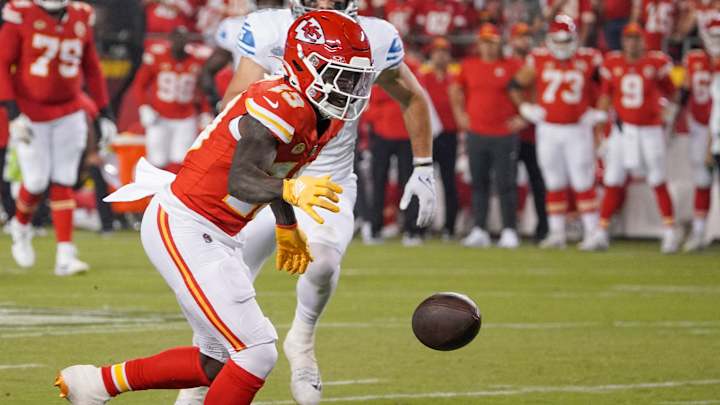SI:AM | The Chiefs’ Biggest Problem Was Obvious in Loss to Lions

Good morning, I’m Dan Gartland. I hope every game this weekend is as good as last night’s.
In today’s SI:AM:
✅ Picks for the rest of Week 1
If you're reading this on SI.com, you can sign up to get this free newsletter in your inbox each weekday at SI.com/newsletters.
Well, the opener gave us plenty to talk about
There’s no better way to get fans talking than for the defending Super Bowl champions to lose a frustrating game at home against one of the league’s most historically inept franchises.
The Lions beat the Chiefs in Kansas City last night, 21–20, in a thrilling beginning to the new season. Earning a hard-fought victory over a team that has dominated the league for the past half decade was a fantastic way for Detroit to assert its validity as an NFC contender. For Kansas City, it was a stark reminder of the team’s biggest deficiency.
The Chiefs sorely missed future Hall of Fame tight end Travis Kelce, who was sidelined after hyperextending his knee in practice. Kelce has been as integral to the team’s offense as any other player over the past several years, leading the team in receptions in six of the past seven seasons, but Kansas City was expected to lean on him even more this season after the departures of JuJu Smith-Schuster and Mecole Hardman.
Watch the Chiefs with Fubo. Start your free trial today.
Without Kelce, the shortcomings of the Chiefs’ receiving corps were on full display. The biggest disappointments were Kadarius Toney and Skyy Moore, who were expected to play significant roles this season but had one catch for one yard combined. Toney’s performance was particularly awful. He dropped four passes, including one that he tipped into the hands of Lions safety Brian Branch, who ran it back for a touchdown. Moore also dropped a fourth-and-25 prayer on the Chiefs’ last offensive snap of the game.
You can’t pin all the blame on Toney and Moore, though. As a team, the biggest problem for the Chiefs was their inability to convert on third down. As Matt Verderame points out, Kansas City went 0-for-7 on third down in the second half. That’s where Kelce’s absence was felt. Of his 110 catches last season, 78 resulted in first downs. But the Chiefs need to find a way to convert on third down that isn’t a Mahomes pass to Kelce. “The long-term issue is likely not the drops, but the inability to create on third down beyond Kelce,” Verderame writes.
For the Lions, winning the showcase game was a perfect way to introduce themselves to a national audience who might still be sleeping on them after last year’s surprising 9–8 finish. Doubters will say that Detroit won because of the Chiefs’ mistakes, but that would be ignoring several promising developments.
One such improvement was the play of the Lions’ defense. Detroit’s D stunk out loud last season, allowing a league-worst 6.2 yards per play, thanks in large part to a porous secondary. But the Lions signed safety C.J. Gardner-Johnson (who led the league in interceptions with the Eagles last year) and linebacker Alex Anzalone, among others. They also used a first-round pick on linebacker Jack Campbell and a second-round pick on Branch, another safety, whose pick-six last night changed the tenor of the game.
But Conor Orr argues that the most noteworthy part of the Lions’ performance was how they approached the game. Coach Dan Campbell was a laughingstock after promising in his introductory press conference in 2021 that his team was going to bite off opponents’ kneecaps, but that sort of aggression has been the foundation of Detroit’s success. Last night in Kansas City, Campbell coached like someone who wasn’t afraid of anything. He called a fake punt from his team’s own 17-yard line on its second series of the game. Much later in the game, facing a fourth-and-2 from the Kansas City 45, he left his offense on the field to go for it. Despite the play's failure, Orr maintains that Campbell’s decision demonstrated an unshakeable faith in his team and symbolized the new direction for a franchise that has never before graced a Super Bowl:
One single-game result over the course of a 17-game season is consequential, no doubt, but not nearly as much as it would have been had Campbell yanked his offense off the field and decided to surrender.
There are theoretical births and deaths in nearly every moment of a football season, and packaged in that one decision to try to win the game outright (a decision that, we should point out, was also easily defensible from an analytical perspective) Campbell orchestrated the erasure of years of futility, self-loathing and ineptitude.
He killed the old Lions. Out came a contender.
The best of Sports Illustrated

- Conor Orr was the only one of our experts to pick the Lions to win last night. Here are their picks for the rest of the Week 1 games.
- Tomorrow’s Iowa–Iowa State rivalry game will come against the backdrop of a gambling scandal involving players from both teams. But Pat Forde writes that those schools can’t be the only two facing such issues.
- Richard Johnson breaks down which college football games this weekend are actually worth watching.
- Joe Burrow agreed to the biggest contract in league history.
- Coco Gauff cruised into the U.S. Open final with a straight-sets victory over Karolina Muchová.
- North Carolina coach Mack Brown lashed out at the NCAA after receiver Tez Walker, who transferred to Chapel Hill to be closer to his ailing grandmother, was ruled ineligible.
- The Nationals abruptly canceled Stephen Strasburg’s retirement press conference that was originally scheduled for tomorrow, reportedly because the team wants to avoid paying him his full salary.
The top five...
… plays from last night’s NFL opener:
5. Lions DE Josh Paschal’s sniffing out the Chiefs’ jet sweep on third down.
4. David Montgomery’s go-ahead touchdown run.
3. Patrick Mahomes’s shifty scramble.
2. Brian Branch’s pick six.
1. The Lions’ gutsy fake punt in the first quarter.
SIQ
On this day in 1939, Bob Feller picked up his 20th win of the season, becoming the second pitcher in the 20th century to have a 20-win season at age 20 or younger. Who is the only player since Feller to accomplish that feat?
- Mark Fidrych
- Fernando Valenzuela
- Mark Prior
- Dwight Gooden
Yesterday’s SIQ: The first replay review in NFL history took place on Sept. 7 of which year?
- 1981
- 1986
- 1992
- 1999
Answer: 1986. The play in question was the third play from scrimmage of the game between the Bears and Browns at Soldier Field. Chicago center Jay Hilgenberg snapped the ball before quarterback Jim McMahon was ready to receive it, and the ball skittered toward the end zone, where it was pounced on by Al Gross. A replay review determined that Gross had established possession before sliding out of bounds, and thus Cleveland was awarded a touchdown. (You can see the original broadcast footage here.)
The first use of a replay review did not go entirely smoothly, though. When Gross dived on the ball, no one on the officiating crew made a signal, instead waiting for the replay official to decide whether it was a touchdown or touchback. The league later acknowledged that the refs made a “procedural” error in not calling the play on the field before going to the booth for the final word.
The replay system was quite limited at that time. Reviews could be initiated only from the booth or by the request of the officials on the field, and the scope of reviewable plays was narrower than it is today. That’s probably for the best, considering that the replay official had to rely on two VCRs and two nine-inch TV screens to review plays.
NFL owners voted to get rid of replay review in 1992 before bringing it back in ’99.
